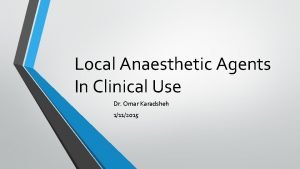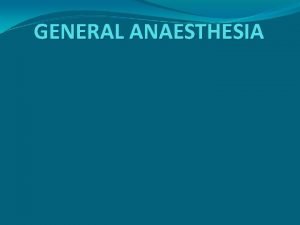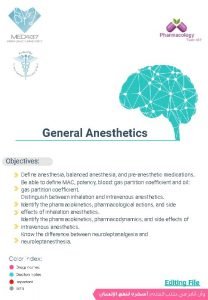General Anesthesia 1 Most anesthetics act on the


- Slides: 2

General Anesthesia 1 • Most anesthetics act on the GABA-A receptor and increase it’s affinity for GABA, consequently increasing GABAergic signaling. • Ketamine is an exception to this rule since it blocks NMDA receptors to cause dissociative effects. • General anesthesia refers to a state of amnesia, anesthesia, unconsciousness and a loss of reflexes. Balanced anesthesia is the plane of anesthesia elicited when using different anesthetics (inhaled and intravenous). Dissociative anesthesia refers to a state of anesthesia where the patient appears awake but is not responsive to stimulus or command Inhalational Anesthetics Halothane, Isoflourane, Enflourane, Sevoflourane, Desflourane, N 2 O • Pharmacokinetics • • The rate of uptake and elimination of these anesthetics is controlled by respiration. Halothane is the exception to this, since it is readily metabolized in the liver. The depth of anesthesia elicited is proportional to the partial pressure of the gas (more drug, more anesthesia). Kinetics of these drugs are primarily determined by their blood: gas partition coefficient which refers to their relative solubility in blood. This value is inversely proportional to uptake, onset of action and elimination. That is, the less soluble the gas (smaller B: G coefficient) the quicker it will enter circulation, sedate the brain and eventually be breathed off. This is precisely because it doesn’t stay in the blood. Other kinetic parameters include the concentration effect, 2 nd gas effect and diffusion hypoxia (these three mainly apply to N 2 O). Concentration effect refers to the fact uptake of a gas facilitates its own uptake so that on-gassing has an non-linear curve. 2 nd gas effect is the phenomenon where uptake of one gas increases the uptake of a second gas. Diffusion hypoxia is produced when gases with very small B: G coefficients are eliminated through the lungs. These anesthetics displace the oxygen within the alveoli and can cause hypoxia which can be corrected by administration of oxygen. • Pharmacodynamics • • • Dynamics for these drugs are primarily determined by their lipid: gas partition coefficient which refers to their ability to cross membranes and reach highlyperfused organs (e. g. the brain). This value is directly proportional to their potency. That is, the higher the L: G coefficient the more potent the anesthetic. A practical measure of potency is the Minimum Alveolar Concentration which refers to the minimum concentration of gas required to anesthetize 50% of the population. MAC decreases with age and balanced anesthesia. The dose-response curve for MAC is steep. With increasing anesthesia there is a decrease in respiratory rate, heart rate, blood pressure (due to decreased cardiac output; ketamine is an exception since it increases CO and BP), swallowing reflex, eyelash reflex, and cerebral O 2 consumption. Cerebral blood flow increases and so does ICP Skeletal and uterine smooth muscle relaxation (not N 2 O) • Toxicity • • • Administration of halothane + succinylcholine is associated with malignant hyperthermia in genetically susceptible disease (e. g. Central Core Disease). This is caused by an inability to re-sequester calcium in the sarcoplasmic reticulum of skeletal muscle. This results in muscle rigidity and dangerous rises in temperature. Treat with Dantrolene Halothane can be Hepatotoxic Sevoflourane is metabolized to Compound A which is nephrotoxic Enflourane can induce seizures (Enflourane causes Epilepsy) Increased secretions and salivary production can lead to atelactasis.

General Anesthesia 2 Intravenous Anesthetics Barbiturates, Propofol, Etomidate, Ketamine • Barbiturates Thiopental, Methohexital, Thiamylal • • Produce rapid anesthesia and is very short acting. It is useful for induction Decreases CO and minute ventilation by desensitizing the CNS to CO 2. Do not use in situations of shock and low BP Don’t produce analgesia Contraindicated in porphyria • Propofol • • • Super short-acting and can create a continual plane of anesthesia with continuous administration Decreases BP by vasodilation and can cause apnea Does not produce analgesia • Benzodiazepines Diazepam, Midazolam, Lorazepam • • • Slower than barbs (midazolam is the fastest) Milder decrease in respiratory depression and do not produce analegsia Can prolong post-anesthetic period. Counteract with flumazenil. • Etomidate • • • Short-acting non-barbiturate Not associated with drops in BP or RR and is therefore useful in shock or hypovolemia Does not produce relaxation and can inhibit corticosteroid/catecholamine biosynthesis and can result in drops in blood pressure later. • Ketamine • • • Dissociative anesthetic that antagonizes NMDA receptors Increases BP and CO Can be hallucinogenic • Opioids Morphine, Meperidine, Fentanyl, Alifentanyl, etc. • • Potent analgesics used during anesthesia. However in high doses they can be used to induce anesthesia. Decrease respiratory rate and cause trunk muscle rigidity N/v Reverse with naloxone



